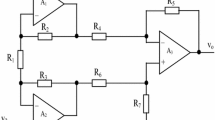Abstract
Alternating current (AC) sources which provide currents in micro ampere ranges have become essential for testing of electronic components, simulation of sensors, eddy current analysis, small signal analysis of transistors, electro-cutaneous stimulation in therapeutics, current injection in medical imaging techniques etc. This manuscript proposes a precise voltage mode AC source for extremely low current values. A simple AC source with load in the feedback is optimised experimentally by compensating the capacitive effects (approx. 4.7 pF) by employing a novel combination of general impedance converter (gic) or Negative Capacitance Converter (NCC) circuits along with basic circuit. The design is proposed with precise value of 160 \(\upmu A\) for applications including physiological measurements. It is seen that GIC circuit modification offers better consistency and performance in load analysis compared to NCC. Load analysis (10–2000 \(\Omega\)), frequency analysis (100 Hz to 1 MHz), stability analysis and reliability testing confirm the optimised and precise operation of the proposed current source. With very high degree of matching in theoretical and practical results, calculation of output impedance is also done and the value is fair enough. The hardware incorporates direct digital synthesis chip driven by a microcontroller for generation of sine wave, thereby reducing the need of bulky power supplies and function generators. This precise alternating current source is suitable for wide band portable applications.










Similar content being viewed by others
References
Jaeger, R. C., & Blalock, T. N. (2011). Microelectronic circuit design. In Lange, M. (ed.) New York: McGraw Hill.
Poletto, C. J., & Doren, C. L. V. (1999). A high voltage, constant current stimulator for electrocutaneous stimulation through small electrodes. IEEE Transactions on Biomedical Engineering, 46(8), 929–936.
Moore, J. S., Gibson, P. R., & Burgell, R. E. (2018). Neuromodulation via Interferential electrical stimulation as a novel therapy in gastrointestinal motility disorders. Journal of Neurogastroenterology and Motility, 24(1), 19–29.
Bragos, R., Rosell, J., & Riu, P. (1994). A wide-band AC-coupled current source for electrical impedance tomography. Physiological Measurement, 15(2A), A91.
Abbas, S., Gillani, U., Ahmed, S., Javed, S. B., Sajid, I. (Dec 2014) Constant current AC source using improved howland pump for exciting eddy current testing probe. In 17th IEEE international multi topic conference 2014 (pp 508–513).
Bertemes-Filho, P., Felipe, A., & Vincence, V. C. (2013). High accurate howland current source: Output constraints analysis. Circuits and Systems, 4(7), 451–458.
Tucker, A. S., Fox, R. M., & Sadleir, R. J. (2013). Biocompatible, high precision, wideband, improved howland current source with lead-lag compensation. IEEE Transactions on Biomedical Circuits and Systems, 7(1), 63–70.
Tietze, U., Schenk, C., & Gamm, E. (2008). Electronic circuits: Handbook for design and application (2nd ed.). Berlin: Springer.
Falstad. Howland current pump. Tech. Rep. http://www.falstad.com/circuit/e-howland.html.
Seoane, F., Macias, R., Bragos, R., & Lindecrantz, K. (2011). Simple voltage-controlled current source for wideband electrical bioimpedance spectroscopy: Circuit dependences and limitations. Measurement Science Technology, 22(115801), 11–23.
Sedra, A. S., & Smith, K. C. (2004). Microelectronic Circuits (5th ed.). Oxford: Oxford University Press.
Xin, H., Li, Z., Dong, W., Zhang, L., Wang, Z., & Zhao, J. (2017). Grounded generalized impedance converter based on differential voltage current conveyor (DVCC) and its applications. ZANCO Journal of Pure and Applied Sciences, 29(3), 118–127.
Yamanaka, S., Matsumoto, K., Horii, Y. (Dec 2015) Theoretical study on operational-amplifier-based negative impedance converters with symmetrically allocated impedance elements. In 2015 Asia-Pacific microwave conference (APMC) (vol. 3, pp. 1–3).
Trump, B. (2012). Oscillations and Stability. https://e2e.ti.com/
Munoz, D. R., Moreno, J. S., Escriva, C. R., Berga, S. C., & Anton, A. E. N. (2008). Constant current drive for resistive sensors based on generalized impedance converter. IEEE Transactions on Instrumentation and Measurement, 57(10), 2290–2296.
Author information
Authors and Affiliations
Corresponding author
Additional information
Publisher's Note
Springer Nature remains neutral with regard to jurisdictional claims in published maps and institutional affiliations.
Rights and permissions
About this article
Cite this article
Sruthi, S., Dhavse, R. & Sarvaiya, J.N. Precise, portable and wide band alternating current source for extremely low current values. Analog Integr Circ Sig Process 102, 273–282 (2020). https://doi.org/10.1007/s10470-019-01430-0
Received:
Revised:
Accepted:
Published:
Issue Date:
DOI: https://doi.org/10.1007/s10470-019-01430-0




